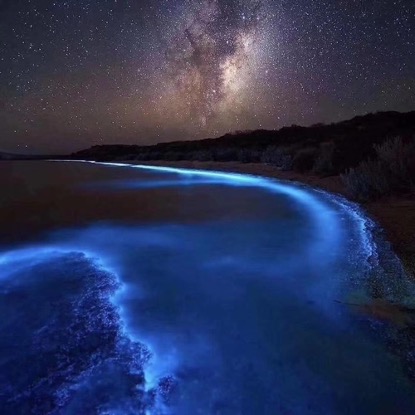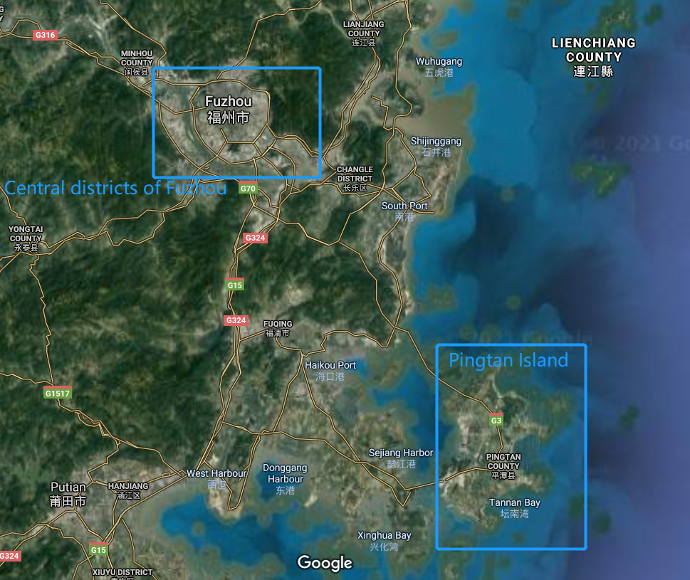Blue Tears
An Interpretation of the Relationship between Coastal Sightseeing, Marine Environmental Change and Knowledge of Bioluminescence in the Marine World

Author: Kunyan Zheng
In recent years, China has witnessed an increasing number of reports of “blue tears”, which refers to occasions when seas glint with blue light in the moonlight. This is an impressive and charming coastal natural phenomenon in Pingtan Island (25°16’-25°44’N, 119°32’-120°10’E), a county affiliated to Fuzhou, the capital city of Fujian Province. This island has preserved most of its local culture and natural scenery, since there was no land access between Pingtan and the central areas of Fuzhou, and the natives of the island can only use ships and boats to travel to other parts of Fuzhou.

The growing number of reports of “blue tears” is accompanied by a rising number of tourists, who are keen to go to this island to enjoy the spectacular seascapes in their holidays. After spending their busy weekdays, people living in the city centre usually go to the outskirts to enjoy natural beauties to refresh themselves. Pingtan Island has been a popular option for them, especially in the days of “blue tears”. Sitting on the beach or the stones in a quiet night, tourists can enjoy the mild winds sweeping against their faces, the sound of the waves echoing in their ears, and the shining stars in the sky illuminating their eyes. Whenever there are “blue tears”, sightseers tend to fill the beach and wait for the surreal seascape appearing on the surface of the sea. Apparently, “blue tears” has already become one of the attractive icons of this island, which has been contributing to the tourism there in recent years.


The poetic nickname “blue tears” is quite familiar to the public, as the media prefer to use this term to refer to this natural phenomenon. With a lack of formal names of “blue tears” in the media, many people, including those travelling to Pingtan, do not have an explicit concept of what the nature of “blue tears” is, what factors contribute to such a spectacular scene, and what the ecological implications are.
How are “blue tears” created?
The nature of “blue tears” is bioluminescence, a kind of luminescence. In 1888, the term luminescence was first used by Eilhardt Wiedemann (1852-1928), a German physicist and historian of science, to describe “all those phenomena of light which are not solely conditioned by the rise in temperature”(3). He demonstrated that luminescence or “cold light” was the opposite of incandescence or “hot light”(4). Drawing on the method of excitation, Wiedemann classified luminescence into six categories, including photoluminescence, thermoluminescence, electroluminescence, crystalloluminescence, triboluminescence and chemiluminescence. In accordance with such typology, bioluminescence is a kind of chemiluminescence.(5)
In the twentieth century, scientists developed new understandings of luminescence. In his book A History of Luminescence published in 1957, Edmund Newton Harvey, an American zoologist at Princeton University and one of the leading scholars on luminescence, identified eight kinds of luminescence with his own definitions: fluorescence, thermoluminescence, electroluminescence, galvanoluminescence, sonoluminescence, triboluminescence/piezoluminescence, crystalluminescence, chemiluminescence, and bioluminescence (6). Harvey extracted bioluminescence from chemiluminescence, and defined bioluminescence as “the chemiluminescent emission of light by living animals and plants”(7). The typology and definition of bioluminescence become a bit clearer with Harvey’s efforts.

Long before the publication of A History of Luminescence, Harvey had investigated some luminous marine animals, among which were protozoa (such as flagellates)(9) and crustacea (such as ostracods) (10), both of which are mentioned frequently by our contemporary media in China in their attempt to explain the bioluminescence in the marine world. In 1917, Harvey published a paper titled Studies on Bioluminescence(11). Drawing on his investigations on Cypridina hilgendorfii, a Japanese ostracod crustacean, he claimed that “the luciferase is the source of the light” (12), that the light from luciferase could be obtained by “substances incapable of oxidation (NaCl, chloroform, ether, etc)”, (13) and that the “new names of photogenin or light producer for luciferase, and photophelein or light assistor for luciferin have therefore been proposed.” (14) This indicates the most essential mechanism of bioluminescence of marine life.
With the advancement of modern technology, contemporary scientists have developed a more comprehensive and profound understanding of bioluminescence. Steven H.D. Haddock, Mark A. Moline and James F. Case conducted research on bioluminescence in the sea, including a tree of bioluminescent organisms which give off subtle lights in both terrestrial and marine environments; evolutionary origins; chemistry and molecular biology; diversity of bioluminescence; ecology, behavior and physiology; functions of bioluminescence; and oceanographic distribution and population dynamics. According to this paper, the bioluminescence in the seas can be caused by diverse marine life, including bacteria, dinoflagellates, radiolarians, ctenophores, cnidarians, annelids, molluscs, crustaceans, echinoderms, tunicates, fish, and other worms.
What causes "blue tears'" or "milky seas"
Although many marine flora and fauna can lead to bioluminescence, microorganisms are the main causes of the “blue tears” in East Asia. The “blue tears” in Pingtan is caused by a kind of crustaceans, Vargula hilgendorfii, which is also called Cypridina hilgendorfii, sea firefly and blue sand. In southern California, bioluminescence in the seas results from a bloom of dinoflagellates, Lingulodinium polyedra. It appears at the time of a “red tide” and the cells give off blue lights when they are stimulated by “wave action on the beach” (15). The nicknames for bioluminescence in the marine world can also be quite different. For example, it is called “blue tears” in China, while “milky seas” in some other places. Nevertheless, what is in common is that the public seems to pay little attention to the scientific knowledge of bioluminescence, and what ordinary people care about is the beauty of such a natural phenomenon.
One of the reasons why there is a gap between scientific studies and popular perceptions lies in the lack of communication between the two and the primary aim of scientific studies. The significance of studying luminescence (including bioluminescence), as Harvey puts in the preface of A History of Luminescence, is as follows: “The importance of luminescence at the present time stems from the fact that it is fast becoming the universal method of commercial illumination, and also of communication, through the television screen. Moreover, it has played an all important part in the discovery of electrons. X-rays, and radioactivity. What better justification than this for the history of a subject which is destined to play a still greater role in everyday life as we progress further and further into the atomic age.”(16) It is true that bioluminescence has many application values, just like other kinds of luminescence. Scientists are aware of scientific values and potential role of bioluminescence in people’s daily life. However, the moral concerns, such as the concern for the health of the marine environment, are sometimes lost in scientific studies.
Some dinoflagellates may cause poisonous changes in the marine environment. The paper written by Haddock, Moline and Case demonstrates that in large numbers, some species, including “Gonyaulax (=Lingulodinium), Noctiluca, Protoperidinium, and Pyrocystis”, may lead to toxic red tides. (17) For instance, the red tides and bioluminescence in the seas along the coast of Southern California can be attributed to a bioluminescent dinoflagellate called Lingulodinium polyedrum (formerly named Gonyaulax polyedra). (18)
What is the environmental impact of "blue tears"?
The general public is not fully aware of the underlying environmental implications of “blue tears”. The following graph of the case of Fujian province reveals that “blue tears” tends to attract more public attention than red tides in the media.

Moreover, the majority of studies of bioluminescence in the marine world have been conducted by natural scientists, while humanities scholars, including marine environmental historians, have not paid much attention to it. The majority of marine environmental history studies have concentrated on macro-organisms, such as various fish species, and visible materials, such as plastic bags and oil, in the marine world. While the stories of micro-organisms, such as those giving rise to “blue tears”, and tiny molecules, such as microplastics, have not been well-known to either scholars or people outside academia.
In conclusion, the relationship between coastal sightseeing, marine environmental change and knowledge of bioluminescence in the marine world can be revealed in the vivid, complicated, and thought-provoking story of “blue tears”. Tourists are fascinated by the beauty of bioluminescence in the marine world, but many do not have a clear concept of the cause of this natural phenomenon. Natural scientists have been studying bioluminescence in the marine world for over a century and have made some great achievements, though there are still many unknown aspects of marine bioluminescence, including the potential environmental impacts. Besides, there is a gap between scientific knowledge of bioluminescence, human sciences’ interpretations of this natural phenomenon, public imagination of “blue tears” and the authentic conditions and changes in the marine environment. Therefore, a lot of promising work on the issues related to bioluminescence in the marine world is expected.
References

